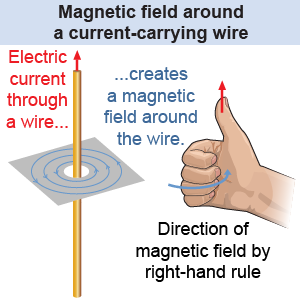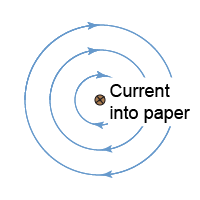|
During a class lecture in 1820, Danish physicist Hans Christian Ørsted placed a compass near a wire that was carrying electric current. The compass needle moved as if the current-carrying wire were a magnet. Switching the direction of voltage in the wire caused the current to flow in the opposite direction in the wire; the compass needle also switched direction. Prior to Ørsted’s discovery, physicists had treated electricity and magnetism as if they were two separate subjects. The English chemist and physicist Michael Faraday showed the connection between changes in magnetic fields and induced electric current in 1822. By 1861, the Scottish physicist James Clerk Maxwell tied together the fundamental properties of electromagnetism in his four equations, possibly the most elegant equations in all of science. Taken together, these scientists showed that magnetism and electric currents were two different manifestations of one underlying physical phenomenon: electromagnetism. 
|
Magnetic field around a current-carrying wire
|
 Ørsted’s discovery was that electric current creates a magnetic field. What direction is that magnetic field? If the current flows in a straight wire, the magnetic field lines form concentric circles around the wire. What does a circular magnetic field line mean in practice? Imagine placing a compass needle (a test magnet) some distance away from the wire. Draw an imaginary circle centered on the wire that passes through the compass needle. The compass needle’s north magnetic pole will point in a direction that is tangent to the circle surrounding the wire. In other words, the magnetic field will point in a direction that is perpendicular to the radius of the circle at that location along the circle. If the compass is moved in a circle around the wire, its direction will rotate so that it always points tangential to a circle centered on the wire.
Ørsted’s discovery was that electric current creates a magnetic field. What direction is that magnetic field? If the current flows in a straight wire, the magnetic field lines form concentric circles around the wire. What does a circular magnetic field line mean in practice? Imagine placing a compass needle (a test magnet) some distance away from the wire. Draw an imaginary circle centered on the wire that passes through the compass needle. The compass needle’s north magnetic pole will point in a direction that is tangent to the circle surrounding the wire. In other words, the magnetic field will point in a direction that is perpendicular to the radius of the circle at that location along the circle. If the compass is moved in a circle around the wire, its direction will rotate so that it always points tangential to a circle centered on the wire. 
 |
Electromagnetism is the field of study of electricity and magnetism together: the ways that electricity generates a magnetic field and the ways that a changing magnetic field can generate electric current. There are many basic applications of these ideas all around you.
An electric generator converts a mechanical motion, such as the rotation of an axle, into electricity by changing the magnetic field through a loop of wire. Electric generators are found in hydroelectric and other kinds of power plants as well as under the hood of a car.
An electric motor converts electricity into mechanical motion by using the magnetic fields from a changing electric current to cause magnets to move. The electric motor is found in many appliances, such as the turntable of a microwave or CD/DVD player, the spinning blades of an electric shaver, and the electric engine in a hybrid or electric car.
A transformer uses the changing magnetic fields created by a variable electric current in one wire to induce an electric current in another wire. Transformers are widely used in the electrical power transmission grid. 
|
The right-hand rule is a way to visualize the direction of the magnetic field caused by an electric current. Point the thumb of your right hand in the direction of the electric current and your fingers curl in the direction of the magnetic field lines. 
|

|
The magnetic field lines around a current-carrying wire trace out concentric circles. That means that, at any particular location, the direction of the magnetic force is tangential to a circle. To find the tangent to a point on a circle, draw a radial line connecting the point with the center. The tangent is perpendicular to this radial line. 
 |
The tangent to a circle is a geometry concept that has many applications in physics, not just to the magnetic field around a current-carrying wire. For example, the velocity of a body in circular motion around another—such as the Moon around the Earth—always points in the tangential direction. 
|
Draw the magnetic field lines around a wire perpendicular to the page and carrying current directly into the page.
 |
 By using the right-hand rule, the answer is illustrated at right.
By using the right-hand rule, the answer is illustrated at right. 
|

